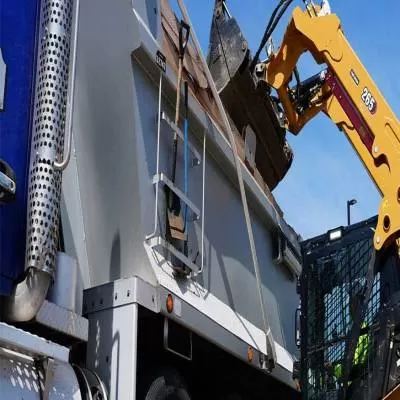- Home
- Technology
- Here’s how the 4D model can help the construction industry

Here’s how the 4D model can help the construction industry
Read full article
CW Gold Benefits
- Weekly Industry Updates
- Industry Feature Stories
- Premium Newsletter Access
- Building Material Prices (weekly) + trends/analysis
- Best Stories from our sister publications - Indian Cement Review, Equipment India, Infrastructure Today
- Sector focused Research Reports
- Sector Wise Updates (infrastructure, cement, equipment & construction) + trend analysis
- Exclusive text & video interviews
- Digital Delivery
- Financial Data for publically listed companies + Analysis
- Preconceptual Projects in the pipeline PAN India
Greg Demchak has had an illustrious career path aligned with technology – from being involved with Revit back in the early 2000s to SYNCHRO about five years ago and now Director - Digital Innovation Lab with Bentley. He tells us about the state of construction software today and explains what’s no longer a thing of sci-fi today, but actual reality. Can you give a brief overview on how construction technology solutions have evolved over time? When I began my career at Revit technology, which was a start-up acquired by Autodesk, it began a path for me to get the market interested in the idea that 3D modeling is approachable and something that architects and contractors should be doing. It set a foundation for BIM, and architects started using it, leading the construction companies in leveraging their 3D models. This logical progression led me to SYNCHRO. Once the market started building intelligent 3D models, contractors started requesting access to those models. So, you had architects sharing these models with construction companies, and construction companies taking these models and sequencing them. That is SYNCHRO’s value. You can take a BIM model into SYNCHRO, import the schedule and link the two together to produce a digital simulation of construction. But, we would not have gotten to the capabilities of SYNCHRO if we did not have 3D modelling and BIM first. There is another aspect to BIM too, in that you have all the quantities coming through the elements – the numbers, square footage, volume of materials – and you can use those quantities in BIM to compute the production rate of installation, i.e. amount of steel installable or amount of concrete pourable per day. Knowing those quantities directly impacts your construction schedule, which leads to a model-based planning using production rates. You can also track your production against the 4D model, called production monitoring. What do you think is the future of Digital Twin technology? I do think what we call a digital twin will be the evolution of BIM. It is not just a static model that you build with 3D tools. The next evolution – just as SYNCHRO was a natural evolution of BIM – would be the digital twin, and that’s where the asset will be tracked and monitored in real time and updated, where the 3D model becomes a context for real-time information. How a building is being used and its current state is all the information possible to get through the Internet of Things and sensors. The 3D model then will become a live database rather that a static snapshot. If anyone hasn’t already adopted BIM or 3D modelling as a way to deliver a project, we will reach a point where everyone is. From an architecture perspective, I’ve seen everyone from big mainstream tier-one architecture firms using BIM to small two- or three-person shops getting value for it. So, even in the construction space you will see that the adoption of 4D will trickle down into mid-range contractors and not be reserved for just the tier-one firms. How does 4D planning enhance a typical BIM and what is the scope for upgrading going forward? There is immediate value when using 4D, even if you are using 2D graphics to start. From a top-down perspective, you can identify clashes in a work area, such as lay-down zones or access routes, by linking those graphics to a timeline. You can instantly visualise the points of conflict in a way that you would never see on a Gantt chart, and resolve it. It adds a richer visual experience to the construction schedule, irrespective of the quality of graphics. As you start ‘growing up’– you can start with simple 3D massing to identify where the major work is happening – almost like the master planning level, visualising the sequence at any level. As you add more resolution to your 3D model, you add more resolution to the sequencing in the schedule. You can go from the master planning schedule – big tasks – all the way down to the scale of workface planning and construction work packaging, in other words, daily or weekly work packages that have to be installed. 4D works across all dimensions leveraging whatever level of detail you have modelled, getting value by linking it to the schedule. Because it is visual in nature, you can see where things won’t work. Typically, illogical sequences or unsafe or hazardous situations might become apparent. People will often find missing scope and will have to add new tasks that wasn’t captured by the planners which will impact the schedule. You can identify clashing spaces between one crew and the next based on how they are installing works, allowing you to negotiate access to space for different crews, just by seeing the 4D model. 4D planning is also used heavily for communications and in the tender phase as well. A lot of contractors will generate a 4D sequence and present that to the owner and try to use that to win the bid. In terms of reality-plus technology, Extended Reality (XR) is the new buzzword. Please tell us about the advances possible and how the infrastructure world stands to benefit. There is a spectrum of interactions for extended reality that goes all the way from full immersion to augmented immersion. The full immersion is what you would think of as a virtual reality headset, like the Oculus Quest II or a Vario, and in that case, you are fully immersed in an extended reality. You can experience 3D models and photogrammetric meshes which give you that one-to-one sense of immersion. On the other dimension, you have what we call mixed reality, like the HoloLens, where you are seeing your physical environment and then you are overlaying and aligning digital models with your physical space. You are not fully immersed in the digital – you are seeing your physical surroundings, but now you are seeing your view augmented with digital content. Somewhere in the middle you also have augmented reality. That is, for example, holding up an iPad or your phone and also seeing computer graphics, but still projected onto a screen. It is not fully immersive like you would get with the HoloLens or VR. Where I am seeing mixed reality has the most value is for operations or if you have to go to a physical facility where there is a need to have a digital alignment of content or a QR code. You can walk up to a QR code and then BOOM, information about that object can pop up in a hands-free way without having to use a phone or an iPad. When they stand in a physical reality and look through this device, they will see what the future superimposed in real time with the physical environment. From the VR perspective, you can dive into a project from anywhere. You don’t have to be on location and you can be fully immersed in the 3D model. So, I think multi-user in a VR experience will be coming next. What are you excited about in terms of the future of architecture and construction tech in India? I would hope that the technology becomes affordable, cost-effective and easy to use. I wouldn’t want this technology to be reserved for tier-one contractors or Western nations who might have the budget to support it. I would love to see this technology be accessible and scalable across the whole market. And we are starting to see that. I think the price of these will continue to fall and that is pretty exciting. In future, the architecture that is built – there will be a whole lifecycle angle here, which is the 3D model – will continue into operations and maintenance, and ‘live’ and ‘grow’ beyond the design and construction phase. It will become a smart building outfitted with sensors so that we can know how it is performing and where it is broken, tying directly into operating and building sustainably. If the building becomes more aware, it can start to manage itself and maybe operate itself more efficiently. How do you see Bentley being a major contributor in India’s infrastructure growth story?By empowering civil engineers, contractors and builders to achieve more with less. Our job is really to provide the tools, technology and the services that would empower Indian contractors and civil engineers to deliver the infrastructure they imagine. Our goal is to capture this idea that we are here to empower them and help them achieve their ambitions, cost effectively, and help them accelerate ambitions the best way that we can.






















